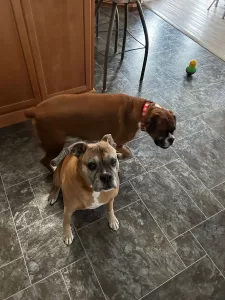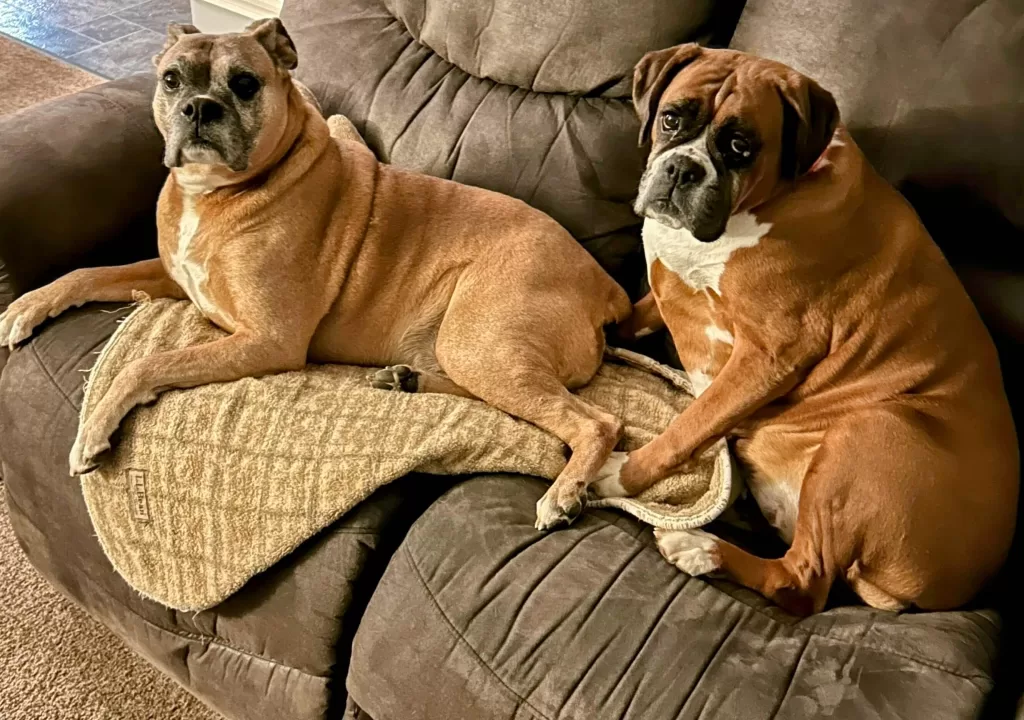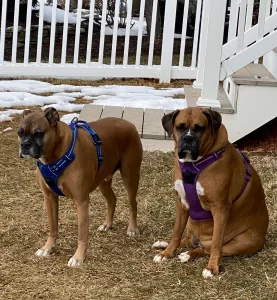This post contains affiliate links. See our Affiliate Disclosure Statement page for more details.
Table of Contents
Boxer Dog Training
Boxer dogs are energetic, intelligent, and loyal pets that make excellent companions for active families. They are known for their playful nature and eagerness to please their owners.
However, without proper training, their exuberance and strong-willed personality can cause problems. Boxer dog training is essential for owners to ensure their dogs are well-behaved and happy pets.
Boxer Dog Training – 6 Effective Training Skills
- Basic obedience training
- Crate training
- House training
- Leash training
- Socialization training
- Advanced training
Boxer Dog Training – Basic Obedience Training
Boxer dogs are intelligent and quick learners, making basic obedience training a breeze.
Basic obedience training should include the following commands
- Sit
- Stay
- Come
- Down
These commands will help you communicate with your dog effectively and establish your position as the pack leader or alpha dog.
Boxer Dog Training – Sit Command

The sit command is one of the easiest commands to teach your Boxer.
- Start by holding a treat above your dog’s head and slowly move it back towards its tail.
- As their head follows the treat, their hindquarters will naturally lower, and they will sit.
- Say “sit” as soon as their hindquarters touch the ground and reward them with the treat.
- Repeat the process until the Boxer can sit when you say sit without presenting a treat.
- Always use positive reinforcement to reinforce the behavior and command being taught.
The American Kennel Club in their article Teach Your Puppy Thes 5 Basic Cues, states “Never physically put your puppy into the sitting position; this can be confusing or upsetting to some dogs.”
We wanted to test our adopted Boxer dog’s skills in learning these basic commands.
Our 10 yr old adopted Boxer Duke, who has lived with us for 8.5 years has already learned the sit command, so he was secluded from this command.
We wanted to determine how long it would take our newly adopted 7-year-old Puppy Mill Mom Katie to learn the sit command.

Katie had spent her entire life in a crate only being brought out to mate and have litters.
She was very scared and skittish of sudden movements and sounds when we adopted her.
While she is slowly acclimating to our house. She still gets very nervous and weary of visitors and jumps at loud sounds or sudden movements.
The results of her training on the sit command are listed below.
Boxer Dog Training – Summary Table for Sit Command
| Trial | Attempts at Learning Command | Time Spent | Success |
| 1 | 10 | 7 min 20 secs | No |
| 2 | 8 | 6 min 45 secs | No |
| 3 | 5 | 5 min 25 secs | No |
| 4 | 3 | 2 min 10 secs | Yes |
We used Superfood Dog Treats with Koji – Peanut Butter Flavor from Wild Earth for this training. Our Boxers enjoy these treats.
Boxer Dog Training – Stay Command
The stay command is the next command to teach your Boxer.
- Start by having your dog sit, and then hold your hand up with your palm facing your dog’s nose and say “stay.”
- Take a step back and reward your dog for staying in the sitting position.
- Gradually increase the distance and duration of the stay command.
- Teach your dog a word that allows them to go and get the treat. For instance, it might be “Go” or “Free” or “Get”
- The releasing word should be a one-syllable word that your Boxer will easily understand.
- Use the stay command and have your Boxer sit and stay until you provide the release word. Reward them with a treat.
- Continue to gradually diminish using treats when using the stay and release commands. Use positive reinforcement to reinforce the desired behavior.

We repeated the same training process with the stay command, however, this time Duke was included in the training process. The results are listed in the table below.
Boxer dog training – Results Table for the Stay Command
| Boxer Dog | Trial | Attempts at Command | Time | Success (Yes/No) |
| Katie | 1 | 12 | 6 min 50 sec | No |
| Day 2 | 2 | 6 | 3 min 20 sec | No |
| Day 3 | 3 | 2 | 1 min 15 secs | Yes |
| Duke | 1 | 4 | 1 min 20 sec | No |
| Day 2 | 2 | 2 | 45 sec | Yes |
We used Cage Free Chicken & Free Range Venison Recipe Jerky Bites Training Treats for Dogs from Only Natural Pet because our Boxers like to eat the treats
Stay Command Training Results
As expected Duke, our older male Boxer was able to learn this command more quickly. This was due in part to several factors
- He had already mastered the sit command for 8 years so this was a more natural transition
- Duke is obedient and eager to learn, so he was actively involved in the training process.
- Duke was used to following instructions and commands
Katie took longer and more attempts initially but was able to grasp the concept on day 3 on the second attempt.
We believe her background initially impacted her ability to grasp the command.
Since they are fed infrequently at the puppy mills they have a strong drive for food. Once she was able to overcome this drive and focus on the command she learned the command quickly
Boxer Dog Training – Come Command
The come command is essential to teach your Boxer, especially when they are off-leash.
- Start by calling your dog’s name and saying “come” in a happy and upbeat.
- When they come to you, reward them with a treat or praise.
- Repeat the process until your boxer comes without being rewarded with a treat.
We tested both our Boxers and they were able to master the concept after 3 attempts.
Both Boxers are adopted and have a strong need for companionship with us.
Often, they will follow us from room to room when they are not tired out from exercise to see what we are doing.
This was a definite benefit for them in mastering this command.
Boxer Dog Training – Teaching the Down Command
The down command is another useful command to teach your Boxer.
- Start by having your dog sit and then hold a treat in front of their nose, slowly lower the treat to the ground, and say “down.”
- As soon as their elbows touch the ground, reward them with the treat.
- Repeat the process until your Boxer can do the command without receiving a treat.
- Remember to use positive reinforcement when learning the command.
Both our Boxers, Duke and Katie learned this command relatively quickly.
The results of this training are listed in the table below.
Boxer Dog Training – Summary Table Teaching the Down Command
| Boxer Dog | Trials | Time | Success (Yes/No) |
| Katie | 1 | 2min 30 secs | No |
| 2 | 2 min 5 secs | No | |
| 3 | 1 min 40 secs | No | |
| 4 | I min 25 secs | No | |
| 5 | 1 min 10 secs | No | |
| 6 | 55 secs | No | |
| 7 | 25 secs | Yes | |
| Duke | 1 | 55 secs | No |
| 2 | 40 secs | No | |
| 3 | 25 secs | No | |
| 4 | 10 secs | Yes |
Since our Boxers love to please and seek our attention, they learned quickly when praised.
We used and recommend Basic Dog Training Commands Training from Holly and Hugo. They helped provide the background we needed for training these commands.
For additional information on training commands, review our articles
9 Best Ways to Mentally Stimulate Your Boxer Dog for a Happy, Obedient, Loyal Companion
Are Boxers Easy To Train? We Tested Our Boxers Abilities to Uncover the Answer
Boxer Dog Training – Crate Training
Crate training is not without its controversies.
There are two schools of thought on crate training
- Putting your dog in a crate is cruel or unethical.
- It is a natural part of the dog’s need to protect its territory. They are den animals and feel comfortable in a crate,
The viewpoint that crate training is cruel and unethical, usually stresses several factors
- Keeping pets in a crate for extended time periods, usually days at a time is cruel and unethical and can harm their psychological and emotional state.
- The crate is often associated with punishment which can have a negative effect on a dog’s psyche.
In the article Why is it cruel to crate animals, PETA (People for the Ethical Treatment of Animals) they state that
“Studies have shown that long-term confinement is detrimental to the physical and psychological well-being of animals.”
In contrast, the other point of view is that crating dogs is not cruel or unethical because dogs are den animals and crating is a natural den-like environment for them.
In the article Crates 101: A guide to Crate Training – The Barking lot, Barkinglot.net states
“Crate training uses a dog’s natural instincts as a den animal. A wild dog’s den is his home, a place to sleep, hide from danger, and raise a family.
The crate becomes your dog’s den, an ideal spot to snooze or take refuge during a thunderstorm. The primary use for a crate is housetraining“.
It’s up to you as the individual to decide whether you want to crate train your Boxer.

Crate training is an effective way to help your Boxer learn to be comfortable and safe in a crate.
A crate can be a valuable tool for house training and preventing destructive behavior when you’re away from home.
Crate training should be done gradually, so your dog doesn’t associate the crate with punishment.
If your Boxer has never used a crate and you want to crate train your Boxer use the steps listed below.
- Put a comfortable bed or blanket inside the crate and leave the door open.
- You can also use treats to lure your dog into the crate.
- Once your dog is comfortable with the crate, start feeding them their meals inside the crate.
- Gradually increase the amount of time your dog spends in the crate, starting with just a few minutes and increasing to several hours
It’s essential to make sure your dog has enough space in the crate to stand up, turn around, and lie down comfortably.
You should also make sure the crate is in a quiet area of your home where your dog won’t be disturbed.
To be completely open and honest, we did not do or need to do crate training.
Duke, our senior Boxer is fine to leave at home when at work for extended times without him getting involved in destructive behavior.
Katie our Puppy Mill Mom Survivor readily goes into the crate and often will run into the crate when she is scared or anxious. She uses the crate as her safe zone.
We typically put Katie in the crate when gone for extended periods because she gets separation anxiety and chews and destroys items (knocks plants over, breaks accessible items
We are continuing to work through this with her to lessen her separation anxiety.
If you want to crate your Boxer we recommend the Midwest Solutions Sport Utility Double Door Crates from Cherrybrook
Boxer Dog Training – House Training

Boxer dogs can be trained to be house-trained using positive reinforcement techniques.
Use the procedure below to help house train your Boxer dog to help prevent having “accidents” in the house.
- Establish a routine for feeding and taking your dog outside for bathroom breaks.
- Take your dog outside immediately after meals, after naps, and first thing in the morning, and last thing at night.
- When your dog successfully goes to the bathroom outside, reward them with treats and praise.
- If your dog has an accident in the house, do not punish them, but clean it up thoroughly to remove the scent.
- Consistency and patience are key to successful house training.
Katie, our Puppy Mill Mom Boxer, although she was 7 years old was not “potty” or house-trained.
Since she spent her life in a crate, she was never taught this concept.
Using the techniques listed above, we were able to house-train her in 3 days, with only an occasional accident.
When your Boxer has an accident in the house we use and recommend #1 All System All-Zymes Odor Eliminator and Natures Miracle Advanced Severe MessEnzymatic Stain and Odor Remover from Cherrybrook.
Boxer Dog Training – Leash Training
Leash training is essential for ensuring your Boxer is well-behaved when walking on a leash.
Use the following procedures to train your Boxer dog to walk well on a leash.
- Choose the right type of harness, leash, and/or collar for your dog. Read our article How to Select the Best Harness for a Boxer Dog – 5 Key Criteria.
- Begin by walking your dog on a short leash and rewarding them for walking by your side.
- If your dog pulls on the leash, stop walking and wait for them to return to your side. Repeat as necessary.
- If they continue to pull and leave your side, reverse direction every time they begin to pull.
- Gradually increase the length of the leash and the duration of the walks
- Always reward your Boxer for good behavior.
We recommend the Joyride Harness Walking Kit which includes the Joyride Harness 2.0, Matching Dog Leash, and Poop Bag Dispenser. Joyride Harnesses are quality harnesses that are great for controlling your boxer dog on walks.
Boxer Dog Training – Socialization Training
Socialization training is crucial for ensuring your Boxer is comfortable and well-behaved around people and other animals.
Follow the techniques below for socializing your Boxer dog.
- Begin by exposing your dog to a variety of sights, sounds, and experiences, such as other dogs, children, and different environments.
- Reward your dog for positive behavior and provide reassurance if they seem nervous.
- Continue to expose your Boxer to people at other dogs at as many venues as possible, for example, kids’ sporting events, walks or playtime in the park, etc.
It’s also important to enroll your Boxer in puppy classes or socialization classes to expose them to different people and dogs in a controlled environment.
We use and recommend the Dog Socialization and Obedience Masterclass from Holly and Hugo.
Boxer Dog Training – Advanced Training
Advanced training can include a range of activities, such as agility training, obedience competitions, and protection training.
Agility training involves teaching your Boxer to navigate through obstacles such as tunnels, jumps, and weave poles.
Obedience competitions involve demonstrating your Boxer’s ability to follow a set of commands in a competition setting.
Protection training involves teaching your Boxer to protect you and your property by teaching them defensive skills.
These types of training should only be done with the help of a professional trainer who specializes in advanced training techniques.
Boxer Dog Training Summary Table
The table below provides a summary of all the training discussed in this article.
Training Summary Table
| Types of Training | Techniques Used | Supporting Materials | Estimated Time to Learn |
| Basic Obedience | Positive reinforcement, Clicker Training, Marker Training | Treats, Leash, Clicker, Collar | 6-12 weeks |
| Crate Training | Positive reinforcement, Gradual introduction | Crate, Treats, Toys | 1-2 weeks |
| House Training | Positive reinforcement, Consistency | Treats, Leash, Poop Bags | 4-6 months |
| Leash Training | Positive reinforcement, Short leash, Rewards | Treats, Leash, Collar | 4-6 weeks |
| Socialization Training | Exposure to different environments, Rewards | Treats, Toys, Puppy Classes | 3-6 months |
| Advanced Training | Professional trainer, Specialized techniques | Agility equipment, Protection gear | 6-12 months |
Summary Table Training Costs and Success Rates
| Types of Training | Cost | Success Rate |
| Basic Obedience | $70-$100 | High |
| Crate Training | $60-$100 | High |
| House Training | $50-$80 | High |
| Leash Training | $80-$150 | Moderate-High |
| Socialization Training | $100-$200 | High |
| Advanced Training | $500-$2000 | High |
Boxer dog Training – Summary
In conclusion, Boxer dog training is essential for establishing a happy and healthy relationship between you and your pet.
Basic obedience training, crate training, house training, leash training, socialization training, and advanced training techniques can help ensure your Boxer is well-behaved and happy.
With proper training and care, your Boxer will be a loyal and loving companion for years to come.

Discoverboxerdogs.com are Mary and Chris Kustanbauter. We reside in Red Lion, PA with our two Boxers, Duke, and Katie, who are both rescue dogs. We have been working with Adopt A Boxer Rescue for the past 17 years and have adopted 5 Boxers from this fine organization. To learn more visit our Home, About Us, and Blogs Pages Visit us on social media on Facebook – All About Boxers, Instagram, and Pinterest.

